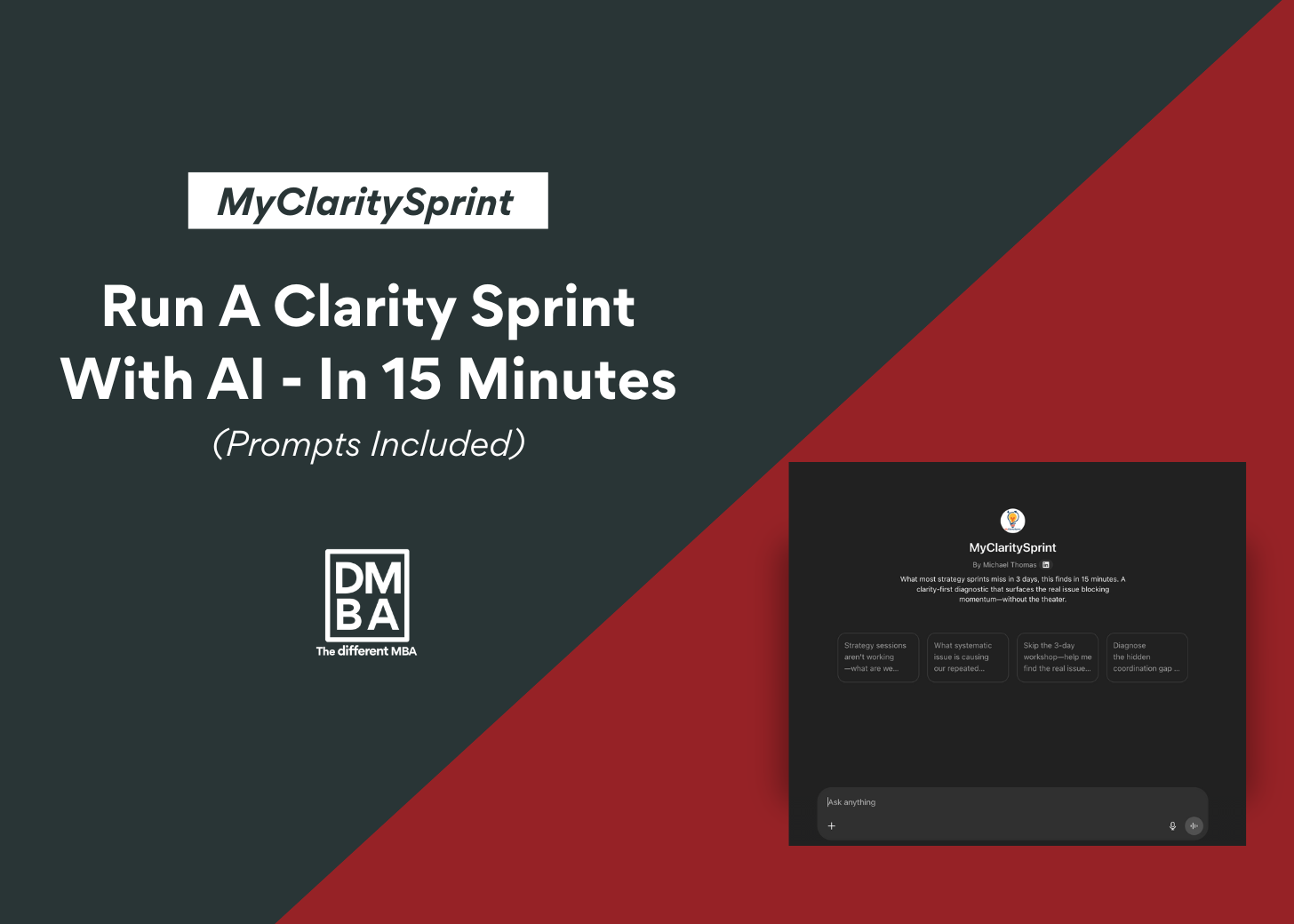How to Run a Clarity Sprint with AI in 15 Minutes (Prompts Included)
Before you align the room, align yourself. This Clarity Sprint replaces drift with direction—in 15 minutes, with AI.
Strategy sprints are powerful—but they often start messy.
Before you can align a room, you need to align yourself.
You walk into a high-stakes meeting, a roadmap review, or a strategy sprint.
And the first 30 minutes (or three days) are spent just trying to name what matters.
That’s the invisible tax most teams pay:
No clear context.
No shared framing.
No forward momentum.
A Clarity Sprint solves that.
It’s a short, focused thinking cycle designed to help you make better decisions faster—before the meeting, before the strategy sprint, before the pitch deck.
And now—with a few AI-native prompts—you can run one solo, asynchronously, and fast.
What Problem Does a Clarity Sprint Solve?
You’re stuck in friction.
Maybe it’s:
A critical decision you’re overthinking
A narrative you can’t quite message
A strategy that feels right—but lacks shape or options
Whatever the case, you’re in motion—but not momentum.
What Outcome Should You Expect?
You don’t need more noise.
You need:
A clear POV on what’s at stake
Directional options to work with
A sense of confidence before the room
That’s what a Clarity Sprint gives you.
How Do You Know It’s Working?
By the end of your Clarity Sprint, you’ll have:
One sharply framed problem or decision
Two to three viable paths forward
A reframed sense of confidence in your next step
Bonus: language you can use to message it clearly to others
The Clarity Sprint Process
You can run this on your own—or with AI acting as your strategy co-pilot.
Use a notepad, a doc, or drop these prompts into a custom GPT.
Step 1: Frame the Problem
What’s the real friction I’m facing right now?
Why is this showing up now?
What’s the cost of inaction?
Step 2: Identify Progress Signals
What does meaningful progress actually look like here?
What’s the outcome I need—not just the deliverable?
Step 3: Explore Options
What are 2–3 paths forward based on what I know now?
Which one is riskiest? Which one feels most aligned?
Step 4: Validate the Direction
Does this path solve the core problem—or just reduce the discomfort?
What would make this path even stronger?
Run the Clarity Sprint with These Prompts
Copy and paste directly into ChatGPT, Claude, or your AI tool of choice.
Prompt 1: Problem Framing
“Act as a strategist. Help me clearly define the root problem I’m facing in this situation: [insert context]. Ask clarifying questions if needed.”Prompt 2: Define Progress
“Based on that problem, what would signal strategic progress—not just activity?”Prompt 3: Explore Options
“What are 2–3 viable paths forward? List risks and advantages for each.”Prompt 4: Validate & Refine
“Which option is most likely to build momentum—and why? What would a skeptic challenge here?”
Here’s how the first Clarity Sprint prompt performs live—framing the real issue using context, not assumptions.
Why It Works
AI without structure creates noise.
But AI with a strategic frame becomes a clarity engine.
The Clarity Sprint isn't about replacing judgment.
It’s about speeding up how you exercise it.
It helps you practice being an AI-native strategist:
Using systems thinking, human context, and digital leverage—in motion.
When to Use It
Before a strategy sprint
Before a key meeting or presentation
Before writing a deck or proposal
When a project starts spinning
Anytime you feel drift instead of direction
Want to Run It Even Faster?
I’ve trained a custom GPT that walks you through this exact Clarity Sprint—step by step.
It’s called MyClaritySprint—your AI-native strategist on call.
🔗 Run your Clarity Sprint now →
Momentum-focused reasoning + counterpoint prep: AI becomes a real-time strategist, not a to-do list assistant.
Most people walk into strategy sprints with half-baked clarity.
You don’t have to.
Run a Clarity Sprint before you get in the room—and watch how the room shifts.






